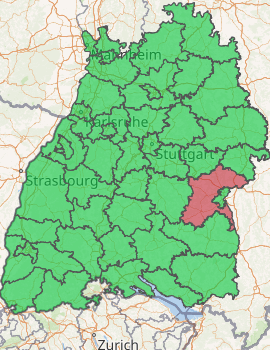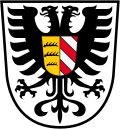Alb-Donau-Kreis
Alb-Donau-Kreis is a Landkreis (district) in Baden-Württemberg, Germany. It is bounded by (from the south and clockwise) the districts of Biberach, Reutlingen, Göppingen and Heidenheim, the two Bavarian districts Günzburg and Neu-Ulm, and the city of Ulm.
Alb-Donau | |
|---|---|

| |
| Country | Germany |
| State | Baden-Württemberg |
| Adm. region | Tübingen |
| Capital | Ulm |
| Area | |
| • Total | 1,357.32 km2 (524.06 sq mi) |
| Population (31 December 2018)[1] | |
| • Total | 196,047 |
| • Density | 140/km2 (370/sq mi) |
| Time zone | UTC+01:00 (CET) |
| • Summer (DST) | UTC+02:00 (CEST) |
| Vehicle registration | UL |
| Website | alb-donau-kreis.de |
History
The history of the region is linked with the history of Ulm and the Swabian Alb.
Listing of Towns and Municipalities in the former Ulm district:
- Albeck (now part of Langenau)
- Altheim (Alb)
- Altheim ob Weihung (now part of Staig)
- Amstetten
- Arnegg (now part of Blaustein)
- Asch (now part of Blaubeuren)
- Asselfingen
- Ballendorf
- Beimerstetten
- Beiningen (now part of Blaubeuren)
- Berghülen
- Bermaringen (now part of Blaustein)
- Bernstadt
- Blaubeuren (town)
- Blaustein
- Bollingen (now part of Dornstadt)
- Börslingen
- Bräunisheim (now part of Amstetten)
- Breitingen
- Bühlenhausen (now part of Berghülen)
- Dellmensingen (now part of Erbach)
- Dietenheim (town)
- Donaustetten (now part of Ulm)
- Dorndorf (now part of Illerrieden)
- Dornstadt
- Eggingen (now part of Ulm)
- Ehrenstein (now part of Blaustein)
- Einsingen (now part of Ulm)
- Erbach (town)
- Ermingen (now part of Ulm)
- Ettlenschieß (now part of Lonsee)
- Gögglingen (now part of Ulm)
- Göttingen (now part of Langenau)
- Halzhausen (now part of Lonsee)
- Herrlingen (now part of Blaustein)
- Hofstett-Emerbuch (now part of Amstetten)
- Holzkirch
- Hörvelsingen (now part of Langenau)
- Hüttisheim
- Illerrieden
- Jungingen (now part of Ulm)
- Klingenstein (now part of Blaustein)
- Langenau (town)
- Lehr (now part of Ulm)
- Lonsee
- Luizhausen (now part of Lonsee)
- Machtolsheim (now part of Laichingen)
- Mähringen (now part of Ulm)
- Markbronn (now part of Blaustein)
- Merklingen
- Neenstetten
- Nellingen
- Nerenstetten
- Oberkirchberg (now part of Illerkirchberg)
- Öllingen
- Oppingen (now part of Nellingen)
- Pappelau (now part of Blaubeuren)
- Radelstetten (now part of Lonsee)
- Rammingen
- Regglisweiler (now part of Dietenheim)
- Reutti (now part of Amstetten)
- Schalkstetten (now part of Amstetten)
- Scharenstetten (now part of Dornstadt)
- Schnürpflingen
- Seißen (now part of Blaubeuren)
- Setzingen
- Sonderbuch (now part of Blaubeuren)
- Steinberg (now part of Staig)
- Stubersheim (now part of Amstetten)
- Suppingen (now part of Laichingen)
- Temmenhausen (now part of Dornstadt)
- Tomerdingen (now part of Dornstadt)
- Türkheim (now part of Geislingen an der Steige in Göppingen)
- Unterkirchberg (now part of Illerkirchberg)
- Unterweiler (now part of Ulm)
- Urspring (now part of Lonsee)
- Waldhausen (now part of Geislingen an der Steige in Göppingen)
- Wangen (now part of Illerrieden)
- Weidenstetten
- Weiler (now part of Blaubeuren)
- Weinstetten (now part of Staig)
- Westerstetten
- Wippingen (now part of Blaustein)
The district of Alb-Donau was established in 1973 by merging the former districts of Ulm and Ehingen, some municipalities of the Münsingen district and the municipalities of Oberbalzheim and Unterbalzheim of the Biberach district.
Geography
The city of Ulm is surrounded by the district. It is the administrative seat of the Alb-Donau district, although it is not part of the district.
The district is named after the Danube River (German Donau) and the Swabian Alb (Schwäbische Alb) mountains. The Danube enters the district in the southwest, runs through the southern parts of the district and leaves eastwards to Ulm. North of the Danube banks the hills of the Swabian Alb rise. The hill chain extends from southwest to northeast parallel to the course of the Danube River and is continued on either side of the district. An affluent of the Danube, the Iller River, forms the southeastern border of the Alb-Donau district, before it meets the Danube in Ulm.
Coat of arms

The coat of arms is identical to the coat of arms of the former district of Ulm. The eagle was the heraldic animal of the Free Imperial City of Ulm. The shield displays the deer antlers of Württemberg and the red and white stripes of the Austrian county of Burgau (which the southern parts of the district once belonged to).
Towns and municipalities

References
- "Bevölkerung nach Nationalität und Geschlecht am 31. Dezember 2018". Statistisches Landesamt Baden-Württemberg (in German). July 2019.